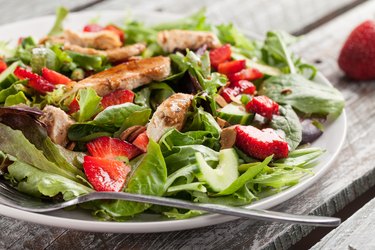
When you donate blood, you literally give a gift that saves lives. Whether you do it out of a sense of moral duty or for the warm glow you get when you help others, never neglect your body's need to refuel.
The right food and proper hydration can help you bounce back after giving blood.
Video of the Day
Video of the Day
In light of the coronavirus pandemic, LIVESTRONG.com is raising awareness about the urgent need for people to donate blood with our Give Blood, Give Back series.
What to Eat After Giving Blood
Once you've given blood, does it really matter what you eat? Actually, it kind of does.
"Focusing on iron-rich foods is going to be key because we want to start getting the mineral back into our body as soon as possible," says Maxine C. Yeung, RD, owner of The Wellness Whisk and a certified personal trainer in California's South Bay area.
Iron supports the production of hemoglobin, which helps move oxygen to your tissues and becomes depleted when you donate, Yeung tells LIVESTRONG.com.
Foods rich in heme iron, the type found in animal sources, include:
- Beef
- Fish
- Poultry
- Seafood
- Eggs
If you don't eat animal protein, you can still bump up your iron intake through non-heme, plant-based sources, such as:
- Leafy greens
- Beans
- Legumes
- Tofu
- Nuts
- Raisins
Pairing iron-rich foods with vitamin C helps your body absorb iron. That's especially important if you rely on plant proteins, Yeung says.
Here are some vitamin C-rich foods to reach for, according to the USDA:
- Guava
- Kiwi
- Bell peppers
- Strawberries
- Oranges
- Papaya
- Broccoli
- Tomato
- Snow peas
- Kale
Remember to Stay Hydrated
Immediately after your donation, expect to be offered a snack. In fact, if you're a frequent blood donor, you might wonder why donation centers dole out cookies, chips, crackers and such.
It's nice to treat yourself for doing good, but there's more to it than that. When you eat salty snacks, you're inclined to drink something — and hydrating after donating blood is really, really important to keep you from becoming lightheaded.
"The highest risk time for fainting is within 15 minutes of donation — that's when your body is squishing fluid back into your veins, so the cookie is just an excuse to make you drink something," says Jed Gorlin, MD, MBA, medical director and vice president of medical and quality affairs for Innovative Blood Resources in St. Paul, Minnesota.
Help yourself to bottled water, juice or a sports drink to replenish some of the fluid you lost by donating blood. Or better yet, bring your own reusable water bottle (that's already filled) from home to drink when you're done.
And don't stop pumping fluids after you leave the donation center. Try to boost your fluid intake for the next 24 to 48 hours, per the nonprofit Advancing Transfusion and Cellular Therapies Worldwide (AABB), which represents blood banks.
Aim for an extra eight 4-ounce glasses of liquid in the 24-hour period after donation, the American Red Cross advises. That's 32 ounces, or nearly one liter, above and beyond what you would normally drink.
Most people's hydration levels will be back in balance within 24 hours, Dr. Gorlin says. Pay extra attention to your fluid intake if you live or work in a hot environment, or if you're working out.
"If your urine is clear, you've done a great job of hydrating," Dr. Gorlin says.
What Not to Do After Donating Blood
Blood donation is very safe, but you'll want to make sure you don't do something that's going to compromise your health. The Red Cross recommends that you:
- Avoid alcohol for 24 hours.
- Skip the heavy lifting and vigorous exercise during that time period.
- Don't put yourself in situations (like climbing ladders) where fainting might lead to injury.
Some people aren't affected too much by blood donation, while others get wiped out, Yeung says. "You have to listen to your body."